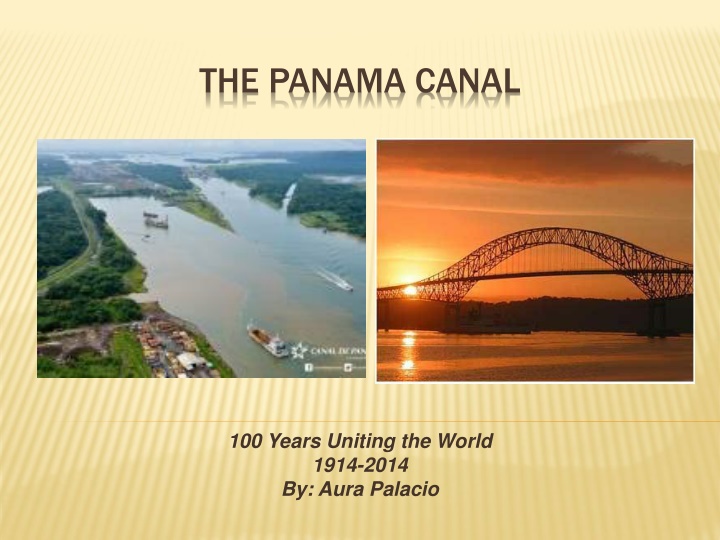The Panama Canal: A Historical Engineering Triumph
The Panama Canal, a symbol of global unity, connects the Atlantic and Pacific Oceans. Its construction faced challenges, including the failed French attempt and Panama's revolution. The canal's completion in 1914 marked a significant milestone, significantly reducing travel time between oceans. Learn about the canal's purpose, construction history, and operational significance.
Download Presentation

Please find below an Image/Link to download the presentation.
The content on the website is provided AS IS for your information and personal use only. It may not be sold, licensed, or shared on other websites without obtaining consent from the author.If you encounter any issues during the download, it is possible that the publisher has removed the file from their server.
You are allowed to download the files provided on this website for personal or commercial use, subject to the condition that they are used lawfully. All files are the property of their respective owners.
The content on the website is provided AS IS for your information and personal use only. It may not be sold, licensed, or shared on other websites without obtaining consent from the author.
E N D
Presentation Transcript
THE PANAMA CANAL 100 Years Uniting the World 1914-2014 By: Aura Palacio
Where is Panama? IS LOCATED IN CENTRAL AMERICA, BORDERING BOTH THE CARIBBEAN SEA AND THE NORTH PACIFIC OCEAN, BETWEEN COLOMBIA AND COSTA RICA
THE FRENCH FAILURE In 1880, the French attempted to construct a waterway pass across the Isthmus but failed mainly because the very sick and dead among the French employees on the Isthmus.
Colombia rejected United States plans to build a canal across the Isthmus of Panama leading later a revolution where Panama became a Republic in 1903.
It is estimated that over 80,000 persons took part in the construction and that over 30,000 lives were lost in both French and American efforts. U.S President Theodore U.S President Theodore Roosevelt Roosevelt Visiting the canal Visiting the canal construction site. construction site.
THE PANAMA CANAL 1904-1914 The building of the Panama Canal took 34 years from the initial effort in 1880 to actually opening the canal in 1914. The building of the canal is considered one of the greatest engineering triumphs in history.
Initially, for military purposes Save money Transport goods faster Quick access to the Atlantic and Pacific oceans WHY BUILD THE CANAL? WHY BUILD THE CANAL?
WHY BUILD THE CANAL? Traveling from Atlantic to Pacific, ships navigated around Cape Horn, the treacherous southern extremity of South America. A New York to San Francisco journey measured some 13,000 miles and took months.
It is a three sets lock system Lifts a ship up 85 feet to the ocean and down again It has a total of six steps (three up, three down) The total length of the lock structure, is over 1.9 miles HOW IT WORKS .. HOW IT WORKS ..
There are two independent transit lanes (each lock is built double) Double lanes allows ships to pass in opposite directions at the same time (large ships pass in one direction only) Each lock chamber requires 26,700,000 US gal of water to fill it from the lowered to the raised position. The same amount of water must be drained again Water is moved by gravity and is controlled by big valves Chamber can be filled in eight minutes HOW IT WORKS .. HOW IT WORKS ..
The gates of the lakes are doubled for safety. Ships are guided by electric locomotives as an important safety feature HOW IT WORKS .. HOW IT WORKS ..
THE PANAMA CANAL IN OPERATION http://www.bing.com/videos/search?q=pana ma%20canal%20&FORM=BVLH1#view=detai l&mid=5AE0FB63473FC7EEA69D5AE0FB63 473FC7EEA69D
THE EXPANSION. The Panama Canal expansion project Panama Canal expansion project (also called the Third Set of Locks Project) will double the capacity of the Panama Canal by 2015 by creating a new lane of traffic and allowing more and larger ships to transit. The project will: Build two new locks, one each on the Atlantic and Pacific sides. Each will have three chambers with water-saving basins. Excavate new channels to the new locks. Widen and deepen existing channels. Raise the maximum operating level of Gatun Lake.[1] (http://en.wikipedia.org/wiki/Panama_Canal_expansion_project)
REFERENCES http://www.binal.ac.pa/binal/ http://www.history.com/videos/panama-canal- locks http://es.wikipedia.org/wiki/Canal_de_Panam%C 3%A1 http://micanaldepanama.com/educadores/pregu ntas-frecuentes/ http://www.slideshare.net/guest03ed30/unit-6- panama-canal-great-powerpoint
MUCHAS MUCHAS GRACIAS GRACIAS POR POR SU SU ATENCI N ATENCI N .. .. http://www.bing.com/videos/search?q=musica+folklorica+paname na&FORM=VIRE3&adlt=strict#view=detail&mid=AB4707652BC20A BF922BAB4707652BC20ABF922B
ACTIVITY - PASSING BY THE PANAMA CANAL Objective(s): Objective(s): Learn how to plan a vacation to the Panama Canal Know the geography of the Caribbean Islands Know the history of the Panama Canal Materials: Materials: White paper (passports) Stapler Glue Stamp Flags (countries to be visited) Decals or stamps Color paper to label Panama canal map (please enlarge for a better view) Caribbean map (enlarge for a better view)
PASSING BY THE PANAMA CANAL Methodology: Methodology: Students create a ship(identify the ship with a flag) and a passport for their imaginary trip (student must be creative) After presenting students the facts about the Panama Canal operation and the geography of the Caribbean Islands, students are ready for the imaginary trip. Use the Panama Canal map to guide them to the Cuenca (Chagres river, Gatun, Alajuela lake, and explain them that it is the main water supplier for the city as well as the water used to operate the canal. Let students use their ship and stop there. Now point to the locks and explain them that each ship has to cross the Gatun lock, the Miraflores lock and the Pedro Miguel in about 8-10 hours. Allow the students to move to the locks with their ship. Students are ready to view different ships that cross the canal every day. Students take turn to place their ship from different countries on the map. Let students share their experience/write a reflection
PASSING BY THE PANAMA CANAL CONTINUING.. Basic Information Basic Information (Refer to these websites) http://history.state.gov/milestones/1899- 1913/panama-canal http://geography.about.com/od/specificplaces ofinterest/a/panamacanal.htm http://www.pbs.org/wgbh/americanexperience /features/general-article/tr-panama/ http://filebox.vt.edu/users/kbartell/Lesson%2 0Plan%20Panama%20Canal.pdf























